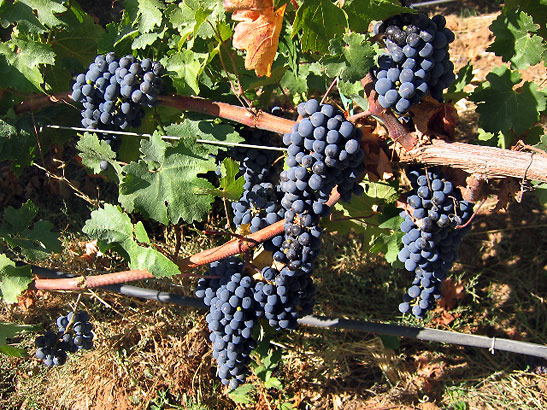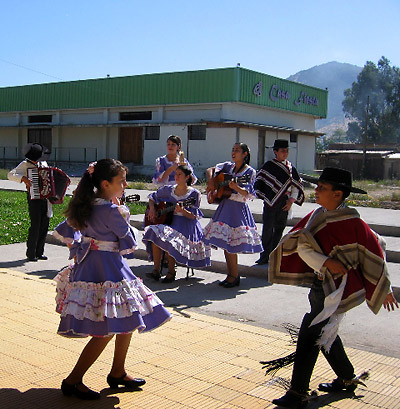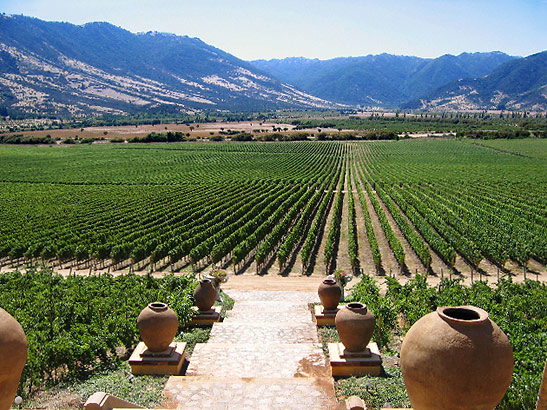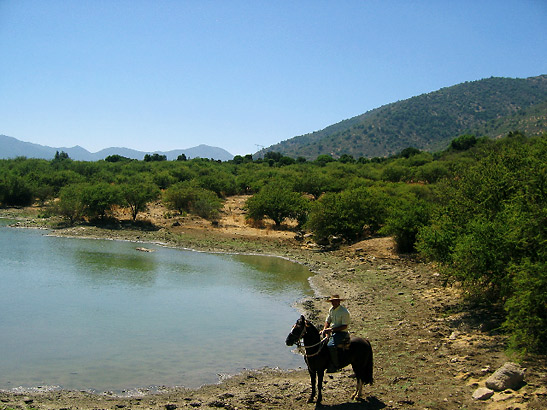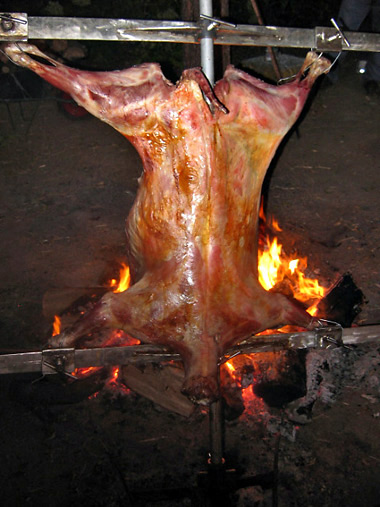 |
 |
|
 |

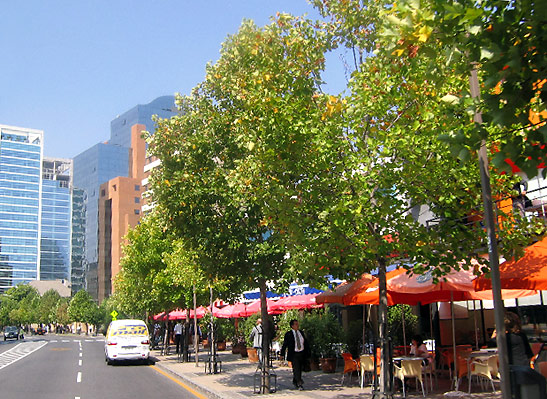 Santiago is a clean, bustling city of six million Chile Is Hot
That evening we watched the earth’s shadow swallow the moon in the private observatory above the Santa Cruz Vineyards, while swallowing Cabernet Sauvignon and warming ourselves by the tasting room fire. It gets chilly in the Chilean foothills of the Andes at night, a quality, according to wine writer Kevin Zraly, that makes the wines rival those of Bordeaux and Napa Valley. Chile is a pastoral country whose serpentine body of 4,200 miles hugs the western coast of South America, beginning at the Peruvian and Bolivian borders. Its volcanic spine rests against Argentina and follows the Andes all the way down to Tierra del Fuego at the bottom tip of South America. Never more than 200 miles wide, the diverse climate and relatively small population (16 million, 80 percent of whom live in urban environments) has preserved a rich farmland resting between the mountains and the sea. The land produces a wide range of crops and the sea’s bounty includes Chilean sea bass, salmon, shrimp and other shellfish. However they have no fossil fuel deposits so all the oil products are imported and gasoline prices are high, about $6 a gallon. Santiago is a bustling modern capital of six million. The commercial success of Chile, based on its mining, fishing and agricultural industries and its citizen’s devotion to hard work, has created one of the richest economies in South America. Most work six day weeks and unlike Spain and other Central and South American countries, they do not take siestas. It is also a safe and clean country. Chileans frown on littering and are very honest. On several occasions cab drivers and merchants corrected my change when I overpaid. And there are great bargains to be had, especially if you shop at ferias, collections of artisan shops, and the currency is easy to figure, there are 500 pesos to the dollar. Unlike other major wine producing areas, there is not a lot of attention paid to wine tourism and very few tasting rooms exist. However some of the larger vineyards do feature fine restaurants, guest facilities, vineyard tours and tastings, but reservations are necessary
An easy way to explore the wine country outside of Santiago is to take the tour that begins at the Hotel Galerias, a beautifully restored Holiday Inn owned by the Santa Cruz Vineyards.
The bus takes you 87 miles south to the town of San Fernando, where you board the Tren del Vino (the wine train) which takes passengers on a 20 minute ride through the vineyards of the Colchaqua valley, voted one of the world’s great red wine regions in 2005. Along the way wine from the area is liberally pored and at the Santa Cruz train station more wine awaits along with appetizers and local folk musicians and dancers. You continue on for lunch at The Santa Cruz Winery in a lovely patio restaurant overlooking the vineyard. On the property is a museum devoted to pre-Columbian and Easter Island art (the island is owned by Chile), and a gift shop and wine store in addition to the observatory perched in the hills above. They also own the Santa Cruz Plaza Hotel in town, which features local dishes and well thought out wine pairings with meals.
Down the road is the historic Hacienda Los Lingues, an estate that has been in the same family for 16 generations. They offer twenty beautifully appointed rooms full of antique furniture. Horse riding is also available on trails that lead up into the hills above the valley, unveiling tremendous views from the backs of the agile native horses.
Diner and breakfast is part of the package and make sure you try the national drink Pisco, which is artfully perfected here. It is similar to a whisky sour but composed of Muscat brandy, lemon juice, sugar and whipped egg whites. The Hacienda makes some great wines including the 2010 Sauvignon Blanc, which was the nicest white wine I tasted during my tour. Like most of the back roads in the wine country, once you get off the main highway, you are driving dirt roads through picturesque farmlands. One dusty road led to ViaWines vineyards, a modern facility only a few years old, but they are already a leader in the Chilean wine industry. They sponsor a number of training programs. While I was there a South African restaurateur from London was taking a month long internship along with four young winemakers from Brazil. It was at the winery where we did a full tasting of Via wines and where I found my favorite red, aptly named “Red One,” under the Chilcas label. It is a blend of five red wines including the Carmenere grape, originally from Bordeaux. The winery also has the Las Chilcas Guesthouse in the middle of the vineyard property, which can provide for up to 20 visitors. Meals are also included and one evening a whole sheep was roasted outdoors in the traditional style, seasoned with salt and splayed out on sticks. It was cooked by rotating it next to a blazing fire of eucalyptus wood. Absolutely delicious.
Other Chilean specialties include corn pie, a corn meal dish with onions, egg, raisins, olives, chicken and beef, wonderful fish soups and fried and baked breads, which are served with homemade salsa called pebre. In the Maipo Valley southwest of Santiago, the historic 1880 Santa Rita vineyard, third largest in Chile, inhabits a long mission-style building and features a central garden, a lovely restaurant open to the public and a contemporary art museum. In Santiago I stayed at the Ritz Carlton, which has an extensive wine program that includes tours of selected vineyards and wine and food pairings in the hotel restaurant 365, which is the number of Chilean wines in stock, one for every day. The wine program is directed by Branko Kerlezi and the restaurant sommelier, who can arrange a flight of wines for tasting. The afternoon I attended we tried ten different wines, from dry Sauvignon Blancs to a delicious late harvest Muscat from Tamaya Vineyard in the Limari Valley. I was even treated to the country’s best beer, Kunstmann, a hoppy pale ale. The hotel also offers a wine bath to guests, which I enjoyed with a glass of Pinot Noir. If You Go Once in a blue moon or lunar eclipse you should plan a Chile reception in this warm and friendly country. LAN Airlines offers daily flights to Chile, by way of Peru and Argentina, with excellent service that features Chilean wine with meals. It was voted “The Best Airline to Central and South America” by the Official Airline Guide and Global Traveler Magazine in 2006. Make sure you pack an extra $100 when you go. There is a one-time immigration fee charged Americans because we charge Chileans the same fee to visit America. For housing options, wine and restaurant information, shopping tips, event listings, guidebooks, brochures and maps, contact the Chilean Tourist Office. For Information on the wine train, visit www.trendelvino.com. Related Articles: |
|
Feedback for South of the Border Wine Country Hello John – I enjoyed reading your article. I live in
La Bufadora and have friends visiting next week, so you have given me some good
tips on where to go in our wine country. We have always called Cetto –
L.A. (like Los Angeles) Chet-o and it might have been worth mentioning that
it is actually Italian in origin. Also, I don't know about when visiting the
Valle, but when in town, it is better to have pesos than dollars. Right now
the rate is approx. 11.70 for each dollar. Just sayin' and like I said good
article!
Hi, We here at Country Living Magazine are working on a story about hotels around the US. We would like to feature the Paso Robles Inn. I have to find photos to go along with the story. I was wondering if you could please send me any images of the hotel. This can be anything from the rooms to the food! All images can be submitted low res and if selected I will ask for hi rez later. Also, if you know of any photographers that have photographed the hotel can you please give me the contact info? Thank you so much! --- Will Morel, Assistant Photo Editor, Country Living Magazine, New York, NY
I am looking forward to my "silver" years, which in my case, will be the years (if fate is good to me) that I will finally be traveling. New Zealand is at the top of the list - I have always been drawn to it. --- Sandra Mines, Seattle, WA
Yes, was a fun city. Bad wine though. --- Bo, Portland, OR
|
This site is designed and maintained by WYNK Marketing. Send all technical issues to: support@wynkmarketing.com

|






